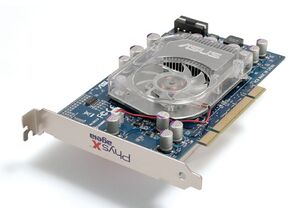Glossary:Physics processing unit
From PCGamingWiki, the wiki about fixing PC games
This page is a stub: it lacks content and/or basic article components. You can help to expand this page
by adding an image or additional information.
- For the sake of simplicity, this article mainly refers to Ageia's Physics Processing units. For more general article, refer to Physics processing unit.
A Physics Processing Unit (PPU) also often referred to as Physics Acceleration Card was a special card dedicated to performing physics calculations, introduced in 2006 by Ageia.
PhysX P1 (PPU) hardware specifications[1]
- Multi-core device based on the MIPS architecture with integrated physics acceleration hardware and memory subsystem with "tons of cores"
- 125 million transistors
- 182 mm2 die size
- Fabrication process: 130 nm
- Peak power consumption: 30 W
- Memory: 128 MB GDDR3 RAM with 128-bit interface
- 32-bit PCI 3.0 (ASUS also made a PCI Express version card)
- Sphere collision tests: 530 million per second (maximum capability)
- Convex collision tests: 530,000 per second (maximum capability)
- Peak instruction bandwidth: 20 billion per second
References
- ↑ Physics processing unit at wikipedia.org - last accessed on 2018-03-22

